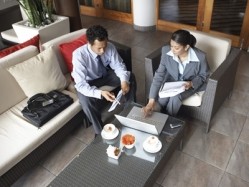Hospitality technology: Engaging the customer after departure

As we’ve seen previously, technology can have a vital role to play in ensuring customers are given the best experience of your business both before they arrive and during their visit, so how can you extend that level of service after when they have walked out the door?
Data capture
Extending service after a visit will depend largely on your business’s ability to capture a customer’s details either at the time of booking or while they are on the premises. Once you have their email addresses you are on your way to keeping that relationship open.
David Miller, head of UK marketing at online reservations and marketing company Livebookings, advises businesses to make use of the increasingly sophisticated data passed on to them by online reservation systems, such as whether a diner books for lunch or dinner or the type of menu they opted for, to enable marketing to be better targeted in the future.
“It’s not just about about securing bookings, it’s about relationship building and as people become less brand loyal, loyalty is going to get much harder, so more sophisticated technology that gives you more detail about their habits can help you retain that loyalty,” he says.
Relevance
Digital loyalty company Eagle Eye agrees that as technology gets more sophisticated it will allow businesses to better cater for customers by giving them the deals or offers relevant to them.
The company, which is already working with restaurant groups Tragus and Gondola and Mitchells & Butlers on loyalty and marketing, supplies a code either by SMS or email to diners which relates to the offer they are looking to redeem.
The diner passes on that code to waiting staff at the point of payment which is automatically applied to their bill (the system integrates with a restaurant’s EPoS system) and giving the customer the discount they want.
However, the chain doesn’t end there. Because the code comes charged with the diners details and is input back into a restaurant’s system, it can be used for future marketing, something Eagle Eye’s Philip Blundell says wouldn’t happen if the diner had brought in a paper voucher they’d printed out.
“We can capture a lot more data this way,” he says. “The restaurant can see for example that a diner likes to take offers up on a Monday and can adjust their marketing accordingly. “From a consumers point of view it is easier too as they don’t have to print out a piece of paper, they just need to take in their phone and access the email or SMS with the code. “
Revenue driver
Using the latest technology to communicate with customers is not only more likely to give them what they want but, if done correctly, will also boost trade.
The Direct Marketing Association states that every £1 spent on digital marketing relates to £40 in revenue for a business and according to Sign-Up.to’s chief executive Matt McNeill, that figure can be higher for hospitality.
“It’s essential to understand that email isn’t a way to directly acquire new customers,” he says, “it’s a way to turn occasional customers into loyal, repeat business.”
Miller agrees. “Email marketing is still the main generator of repeat business.”
Quality feedback
While using email can be a good way to tell customers about the great things you can offer them, it can also be a way to gain quality feedback.
Many hospitality businesses will collate the results of online surveys and use them to improve the business, but a quarterly update may be too late if the customer who has complained about a slow check-in process is returning the next week.
With the help of the latest technology (property management system OPERA to be precise), hotel chain Jurys Inn is aiming to get feedback shared with its frontline staff as soon as the customer hits send on the survey they are sent post departure.
“The survey covers everything relating to their stay, from whether they’ve had a good night’s sleep to their experience at check-out,” says regional operations manager UK North Peter Stack.
“The beauty of it is that once they complete that it feeds live time into our Think Like a Customer (TLC) portal where any member of staff can see the feedback that has come in.”
Serious complaints or more detailed feedback can be sent to directly to a hotel manager via an email link within the same email, but the most important thing, Stack believes, is that responses reach the right people quickly, and technology has a crucial role play in achieving that.
“The old way we did surveys would see a report on customer satisfaction created every three months and circulated among staff, so feedback took a lot longer to reach them. This way, it gets back to staff in real time, meaning they can react quicker and make changes the next day if needed.
“I really think technology and hospitality work together. Since we have invested in technology our check-in satisfaction score is over 90 per cent, which is pretty high considering the volume of guests we are checking in and out every day.
“Friendly receptionists are key to a warm welcome, but they need the tools to deliver that service and that’s why having the latest technology can help them do that.”
For all our articles on hospitality technology click here


























